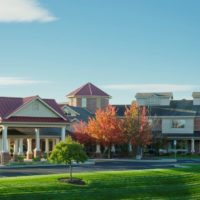It’ll take more than a name change to keep continuing care retirement communities (CCRCs) successful—or even in existence—in the future.
At least, that’s the impression one gets from speaking with a leader in the industry—Doug Leidig, who became president and CEO of Asbury Communities Inc. in June 2015. Asbury’s six communities—in Maryland, Pennsylvania and Oklahoma—together serve more than 3,800 people and employ about 2,700.
Leidig inherited an organization on firm footing, as demonstrated by its annual report. As of 2014, Asbury Communities had exceeded budgeted occupancy levels for the year, ending at 94.2%. It had built its reserves to nearly $100 million, marking three years in which it had surpassed its pre-recession mark set it in 2007, and all its bonds were long-term fixed rate debt at favorable terms.

Yet, Leidig does not believe that Asbury can simply continue with a business-as-usual approach if future reports are to be as positive. Indeed, he believes that Asbury and CCRCs in general will have to increasingly look to expand their models and forge connections with other like-minded organizations, even those that might seem to be competing with them for residents. In a recent conversation with Senior Housing News, Leidig put the issue in stark terms, saying that collaboration could be necessary if CCRCs are to survive.
This is the latest installment of CEO Fresh Take, a series of conversations with new nonprofit CEOs who are taking the reins as signs point to more urgency around scaling up and competing with a booming for-profit sector.
SHN: What overall industry themes or trends are shaping the strategy for Asbury?
DL: We’re no longer a strictly bricks-and-mortar continuing care retirement community model. It’s going into home- and community-based services, home health, palliative care. Serving seniors who don’t necessarily live on our campus. That’s a theme among my peers.
SHN: Are you looking to acquire or develop your own in-home and community-based services?
DL: You have some states that are CON [certificate of need] for home health, so you have to look to purchase one. We just did that this past March in Maryland, in Montgomery County. In other states where we operate, we’re looking to start our own or partner with someone in the community, or possibly purchasing them as well. But collaboration and partnership, it’s one of the things I think that we need to do as nonprofit providers.
SHN: You think it’s a must?
DL: I think we almost have to—none of us can survive by ourselves. We’ve got other groups that are for-profits that are coming in that can build faster and quicker.
SHN: So, let’s talk specifically about collaboration. What does that look like, who are you partnering with?
DL: I think it depends on your market. Down here, there are some larger CCRCs that have good quality that we would want to partner with. In other markets, we wouldn’t want to do that.
SHN: You would work with other CCRCs?
DL: I think you’re going to see more collaboration with nonprofits across various business lines—IT, transportation, not keeping those silos up in our areas.
SHN: And that might mean collaborating with other CCRCs? I could see that as helping your competition, in a way. How does that work?
DL: It’s striking a balance between differentiation and alliance.
SHN: What are some of the key differentiators?
DL: I think your product type is one way nonprofits stand out from each other. One may have more cottages versus apartments. One may have many amenities or fewer. The look of the campus, product mix and price point.
SHN: What about taking collaborative partnerships to the next level, to some sort of more formal affiliation, like the merger of be.group and ABHOW? Should we expect to see more of those?
DL: For a nonprofit facility, you don’t need capital, you don’t need to go out and borrow because it’s a non-cash transaction. But the disadvantage is that it takes a long time, it’s about the boards and staff realizing that the missions and culture are the same. Affiliations take about 12 to 18 months because there are so many steps, and there are few financial incentives for nonprofits to affiliate. In the for-profit world, there’s a financial incentive. That doesn’t happen in our world, it’s all about mission, vision and culture.
They posted some numbers at a recent Ziegler conference, and in the last five years, something like 30 CCRCs have affiliated. After 2008, 2009, you started to see more of that because standalone CCRCs said, I can’t go through a financial downturn again. And in the investment in IT needed, I can’t do it by myself.
The other part is the retiring CEOs. About 50% of multi-sites have a CEO retiring now through the next three years. There’s not a big influx to succeed them and they’re looking to affiliate for longevity.
Right now, single sites are joining systems, and small systems are talking to each other. The large-scale mergers, that’ll happen, but a lot slower. That’s the trend you’ll start seeing on the uptick.
SHN: How are these affiliations coming about, are they being driven because CCRCs are faltering on their own?
DL: When two more progressive CCRCs talk about affiliation, they’re not in dire need.
SHN: What are they talking about when they’re discussion affiliation? How are the relationships between these providers being built?
DL: The conversation can happen in multiple ways. We have a marketing and IT company and we provide services to other nonprofits. That’s one way to create that relationship. They get to know us. There’s different groups I belong to. So it starts as simple as that. There’s discussion, they go back to the board, and then there’s another conversation with team leaders. We just did this in another state we operate in. We say, what’s your mission, what’s ours, what do you have that we don’t, that we have that you don’t, you start to get into due diligence and look for efficiencies, that takes a few months. A lot’s done in the quiet period. Then you bring in others and eventually say, let’s affiliate.
SHN: Are you considering growing outside the three states you currently operate in?
DL: Our growth plan—we have a community in Tulsa. You draw a line down the U.S. and go east, that’s our market. We’re not just going anywhere.
SHN: But you’re casting a wide net?
DL: It’s pretty wide, but we’ve got a disciplined process we’re just starting to work through.
SHN: What about the collaborations or even the acquisitions of other types of providers. How about the home health agency you acquired, how did that come about?
DL: We engaged a recruiter to go out and look for home health in Maryland and contact the ownership to see if they were willing sell, drum anything up. They shook one loose. The integration’s going well because we already had home care established, so the [new agency] gives us another layer.
SHN: And the integration is going well?
DL: Yes. There’s always a learning curve when incorporating a new business line, but it was smaller, it wasn’t a big agency to integrate into our system. It was a nice size. It’s called MDL—those were the initials of the owner running it, she was a nurse. It was small, but active here in Montgomery County, so it was already up and running, she had the relationship with the hospitals and referral agencies. It was a welcome relief to her, we were able to take billing and finance and HR and we were able to consolidate. There’s been growth of 30% in patients being served. That’s a conservative estimate.
SHN: What was the acquisition price?
DL: In the $1.1 million to $1.2 million range.
SHN: Are these acquisitions and collaborations challenging in terms of putting stress on Asbury’s existing culture or workforce?
DL: There’s a renewed sense of everybody’s excited because we’re not a bricks and mortar model anymore, and looking at new collaborations. Looking at the new business lines, and is it a therapy company a pharmacy company next, how do we grow? That’s injected a lot of life into our company.
SHN: Will Asbury be adopting the Life Plan Community term to replace CCRC?
DL: We are aware of the rollout, and moving forward, Asbury will be monitoring how the industry embraces the term before embarking on any sweeping changes.
SHN: Seems like there’s lots of opportunity to collaborate, start to grow the business. What are some of the biggest challenges right now?
DL: Positioning yourself for health care reform. How to position yourself for bundled payment. At the same time, to be able to create that differentiator for yourself. Looking further out, we’ve got workforce issues down the line. As I said, there’s not a lot of executives stepping in, but it’s through all levels of the association. We’ve got to adjust our model, benefits, the way we operate to attract staff. I think that’s a significant issue where we need to step up.
SHN: It sounds like you think the CCRC model will look much different in the future?
DL: I think the model will persist. But I think it’s going look different. Our turnover is going to slow down. The care we’re giving in nursing homes today we maybe give in assisted living, and skilled becomes acute care or transitional care. But people buy into the CCRC for a lifestyle. They’ll still buy into that. It’ll be there as a core but the parts around it are going to change.
Written by Tim Mullaney







